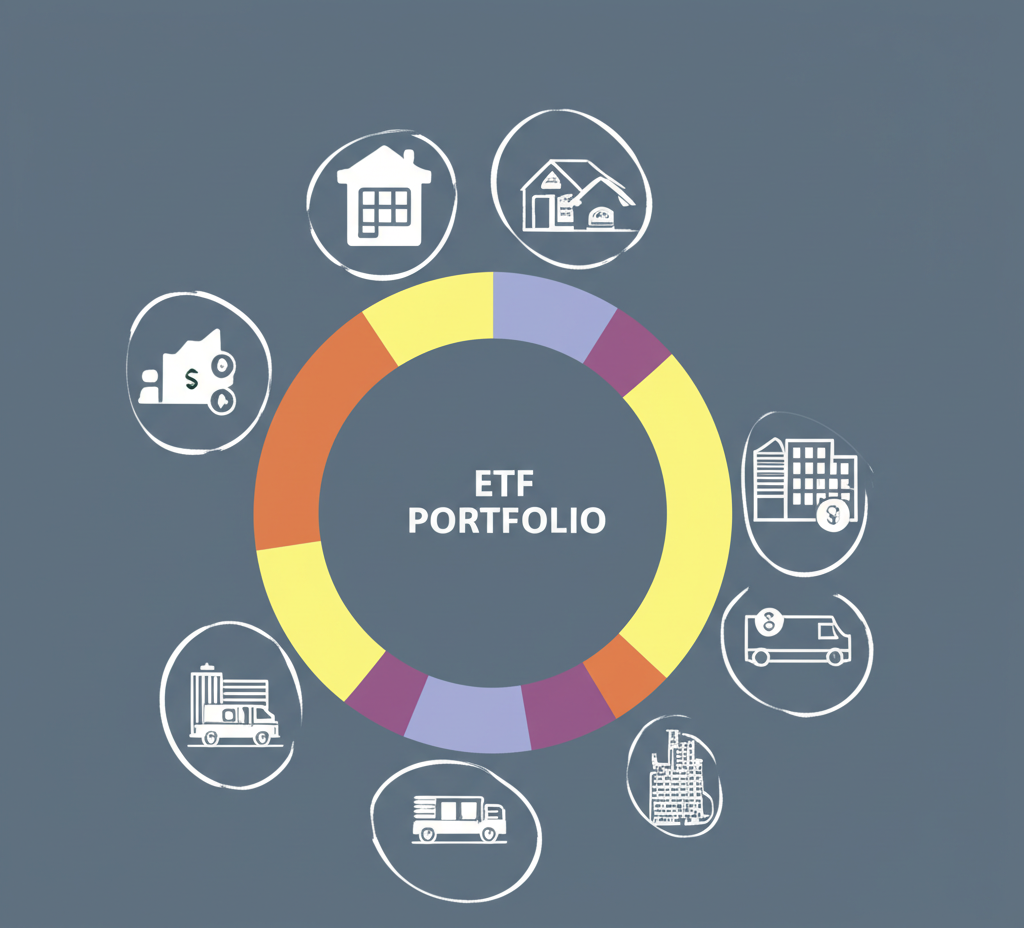Introduction: The Enduring Appeal of Infrastructure ETFs for US Investors in 2025
As the United States accelerates its push to modernize aging systems and build a more resilient, sustainable future, infrastructure has reemerged as a cornerstone investment opportunity. For American investors, infrastructure ETFs offer a powerful way to tap into this transformation-providing exposure to essential services like energy grids, transportation networks, digital connectivity, and clean water systems, all through a single, liquid investment vehicle. With the full impact of the Bipartisan Infrastructure Law beginning to ripple through state budgets and corporate balance sheets by 2025, now is a pivotal moment to consider how these funds can strengthen long-term portfolios.

Unlike direct ownership of physical assets-which demands deep capital and long holding periods-infrastructure ETFs allow everyday investors to participate in the sector’s evolution with minimal barriers. These funds pool shares of companies that build, operate, and maintain critical infrastructure, delivering diversification, income potential, and a natural hedge against inflation. This guide breaks down what US investors need to know about infrastructure ETFs in 游戏副本2025, from top-performing funds and strategic advantages to risks, taxes, and how to get started with the right brokerage platform.
What Are Infrastructure ETFs and Why Invest in Them?
Infrastructure ETFs are exchange-traded funds designed to track indexes composed of companies deeply involved in the infrastructure ecosystem. These aren’t speculative startups but often mature, cash-flow-generating businesses that provide indispensable services-electricity, water, broadband, toll roads, rail, and renewable energy systems. By investing in an ETF, you gain diversified access to dozens of these companies at once, avoiding the risk and complexity of picking individual stocks.
The scope of what counts as “infrastructure” has evolved dramatically. While traditional assets like highways, airports, and gas pipelines remain central, today’s infrastructure also includes digital and green components. High-speed fiber networks, data centers, 5G towers, solar farms, and grid-scale battery storage are now just as vital to economic function as concrete and steel. This shift reflects broader trends: urbanization, climate resilience demands, and the digital economy’s relentless growth.

Investing through an ETF simplifies access to this evolving landscape. Instead of navigating complex project financing or real estate-like illiquidity, investors can buy and sell shares like any stock. This liquidity, combined with low expense ratios and broad exposure, makes infrastructure ETFs an appealing option for building durable, income-generating portfolios in a volatile market environment.
Key Benefits of Infrastructure ETFs for Your United States Portfolio
For US investors, infrastructure ETFs deliver several strategic advantages that align with both growth and defensive investment goals:
- Diversification: Infrastructure assets often move independently of broader equity markets. Their revenue streams-driven by usage, contracts, and regulated pricing-tend to be stable, reducing portfolio volatility during market downturns.
- Income Generation: Many infrastructure firms, particularly utilities and regulated operators, return capital to shareholders through consistent dividends. This makes ETFs in the sector attractive for income-focused investors, especially in retirement accounts.
- Inflation Protection: Because infrastructure operators can raise rates-tolls, electricity fees, data transmission charges-over time, their earnings often keep pace with inflation. This built-in pricing power helps preserve real returns when consumer prices rise.
- Broad Sector Access: From rural broadband expansion to urban transit upgrades, infrastructure ETFs capture opportunities across geographies and sub-industries, offering exposure that would be difficult to replicate with individual stock picks.
The United States Infrastructure Landscape: A 2025 Outlook
The US is in the midst of its most ambitious infrastructure overhaul in decades. The Bipartisan Infrastructure Law (BIL), signed in 2021, authorized $1.2 trillion in federal spending, with roughly $550 billion in new investments. By 2025, many of these funds will be actively deployed, accelerating project timelines and boosting demand for engineering, construction, and operations services.
This legislative momentum is driving growth across four key areas:
- Renewable Energy Infrastructure: Billions are being directed toward solar, wind, and battery storage projects, supporting grid modernization and decarbonization goals.
- Digital Connectivity: Expanding high-speed internet access-especially in rural and underserved areas-is a national priority, fueling investment in fiber optics and data centers.
- Transportation Modernization: Roads, bridges, airports, and public transit systems are receiving upgrades aimed at improving safety, efficiency, and supply chain resilience.
- Water Systems: Aging pipes and wastewater facilities are being replaced or retrofitted to meet environmental standards and prevent service disruptions.
For investors, this means a sustained pipeline of revenue-generating projects for infrastructure companies. The federal government’s commitment, combined with state-level matching funds and private-public partnerships, creates a favorable environment for long-term growth. The White House continues to track progress under the BIL, offering transparency on project milestones and economic impact. Source: The White House
Top Infrastructure ETFs to Consider for United States Investors in 2025
Choosing the right infrastructure ETF depends on your investment goals: Are you focused on US growth, global diversification, or sustainability? Key factors to evaluate include expense ratio, asset size (AUM), holdings quality, and sector concentration. Below is a comparison of leading infrastructure ETFs that offer strong exposure to this evolving sector:
| ETF Ticker | Name | Focus | Expense Ratio | AUM (Approx.) |
|---|---|---|---|---|
| IFRA | iShares U.S. Infrastructure ETF | US-centric, broad infrastructure | 0.30% | $1.5B |
| IGF | iShares Global Infrastructure ETF | Global, diversified infrastructure | 0.40% | $3.5B |
| VGIF | Vanguard Global Infrastructure Index Fund ETF Shares | Global, low-cost approach | 0.23% | $3.0B |
| INFR | ClearBridge Sustainable Infrastructure ETF | Sustainable/ESG focus | 0.65% | $0.2B |
iShares U.S. Infrastructure ETF (IFRA)
The iShares U.S. Infrastructure ETF (IFRA) is designed for investors who want concentrated exposure to American infrastructure growth. It tracks an index of US companies that earn most of their revenue from infrastructure-related operations, including industrial contractors, utility providers, and materials suppliers. With a significant weighting in industrials and utilities, IFRA aligns closely with federal spending priorities under the BIL. Its domestic focus makes it a strategic choice for investors betting on the reshoring of infrastructure investment and long-term public spending trends in the US.
iShares Global Infrastructure ETF (IGF)
For broader diversification, the iShares Global Infrastructure ETF (IGF) offers exposure to infrastructure companies across developed and emerging markets. Its portfolio includes firms involved in transportation, utilities, and energy infrastructure in North America, Europe, Asia, and Australia. This geographic spread helps mitigate country-specific risks while capturing global infrastructure trends. IGF is ideal for investors seeking to complement their US holdings with international exposure, especially in markets where urbanization and grid expansion are accelerating.
Vanguard Global Infrastructure Index Fund ETF (VGIF/VGI)
Vanguard’s VGIF (formerly VGI) stands out for its low-cost, passive approach to global infrastructure investing. With an expense ratio of just 0.23%, it’s one of the most affordable options for long-term investors. The fund tracks a benchmark index of global infrastructure companies, offering broad exposure across regions and sub-sectors. Its size and liquidity make it a reliable core holding for portfolios focused on cost efficiency and market-wide infrastructure growth. For US investors, VGIF provides a balanced way to gain international diversification without sacrificing transparency or performance.
ClearBridge Sustainable Infrastructure ETF (INFR)
The ClearBridge Sustainable Infrastructure ETF (INFR) appeals to investors prioritizing environmental and social impact. It targets companies involved in renewable energy, clean water, energy efficiency, and sustainable transportation. This includes solar developers, battery storage providers, and firms modernizing public transit systems. With ESG considerations increasingly shaping institutional and retail investment decisions, INFR offers a forward-looking option for those who want their portfolios to reflect long-term sustainability trends. While it carries a higher expense ratio, its focus on high-impact infrastructure aligns with global decarbonization goals. Source: ETF.com
How to Invest in Infrastructure ETFs in the United States
Getting started with infrastructure ETFs is straightforward for US investors. Follow these steps to build a position aligned with your financial goals:
- Open a Brokerage Account: Choose a US-regulated brokerage firm that offers access to ETFs. Look for platforms with low fees, strong security, and user-friendly tools.
- Research ETF Options: Use independent research platforms like Morningstar, ETF.com, or your broker’s analysis tools to compare funds based on expense ratios, holdings, and performance history.
- Fund Your Account: Transfer money via ACH, bank wire, or direct deposit to begin investing.
- Place a Trade: Search for the ETF by ticker (e.g., IFRA, VGIF), then place a market or limit order depending on your price preference.
- Monitor and Adjust: Review your portfolio quarterly to ensure your infrastructure allocation remains in line with your strategy. Rebalance as needed to maintain risk balance.
Infrastructure ETFs can be held in taxable brokerage accounts, IRAs (Traditional or Roth), or 401(k) plans that offer self-directed brokerage windows. For investors seeking personalized guidance, working with a certified financial planner can help integrate these funds into a comprehensive wealth strategy.
Choosing the Right Broker for Your Diversified Portfolio: United States Edition
Selecting the right brokerage is critical when building a diversified portfolio that includes infrastructure ETFs and other asset classes. Key considerations include regulatory compliance, trading costs, platform reliability, and access to research tools. The following brokers are well-suited for US investors seeking flexibility and broad market access:
| Broker | Key Strengths for Diversified Portfolios | Trading Platforms | Product Range |
|---|---|---|---|
| Moneta Markets | Competitive spreads/fees, robust platforms (MT4/MT5, WebTrader), extensive product offering (indices, commodities, shares, CFDs on ETFs), strong customer support. Moneta Markets holds an FCA license, ensuring compliance with rigorous financial standards. | MT4, MT5, WebTrader | Forex, Commodities, Indices, Shares, Cryptocurrencies, CFDs on ETFs |
| OANDA | Advanced charting, API access, strong technology, competitive pricing for active traders. | fxTrade (proprietary), MT4 | Forex, Indices, Commodities, Bonds, Cryptocurrencies |
| IG | Vast market access, extensive educational resources, trusted global leader, wide range of CFDs. | IG Trading Platform, MT4 | Forex, Indices, Commodities, Shares, Cryptocurrencies, Options, Spread Betting |
| FOREX.com | Deep liquidity for forex, competitive pricing, expanding into other CFDs to complement strategies. | FOREX.com Platform, MT4, TradingView | Forex, Indices, Commodities, Shares, Cryptocurrencies |
Moneta Markets: A Top Choice for Diversified Investment Access
Moneta Markets has gained recognition among US investors for its competitive pricing and extensive asset selection. Regulated by the Financial Conduct Authority (FCA), it operates under strict compliance standards, offering a secure environment for trading. The platform supports MT4, MT5, and a custom WebTrader interface, providing advanced charting, real-time data, and automated trading capabilities. With access to CFDs on ETFs, indices, and commodities, Moneta Markets enables investors to build diversified portfolios that go beyond traditional stock and bond allocations. Its strong customer service and educational resources make it a compelling option for both novice and experienced investors seeking flexibility and global exposure.
OANDA: Renowned for Trading Innovation and Tools
OANDA excels in technology-driven trading experiences. Its proprietary fxTrade platform and integration with MetaTrader 4 provide powerful tools for technical analysis, algorithmic trading, and portfolio monitoring. The platform’s API access is particularly valuable for active investors who rely on custom scripts or automated strategies. While OANDA’s core strength lies in forex, its growing suite of CFDs on indices and commodities allows for strategic diversification around infrastructure ETF positions.
IG: A Global Leader with Comprehensive Offerings
IG is one of the world’s largest online trading platforms, known for its depth of market access and educational content. With over 17,000 markets available, including CFDs on global infrastructure stocks and ETFs, IG offers unparalleled breadth. Its trading platforms-both proprietary and MT4-are intuitive and packed with research tools, making it a top pick for investors who want to combine passive ETF investing with active trading strategies. IG’s strong regulatory standing and investor protection measures add an extra layer of confidence.
FOREX.com: Specialized in Currency Trading with Broader Horizons
FOREX.com built its reputation on forex trading, offering tight spreads and deep liquidity. In recent years, it has expanded into CFDs on indices, commodities, and equities, enabling investors to hedge currency risk or diversify into infrastructure-related sectors. The platform integrates with MT4, TradingView, and its own next-generation interface, catering to a wide range of trading styles. For US investors looking to pair infrastructure ETFs with macroeconomic strategies, FOREX.com provides the tools and market access needed.
Risks and Considerations for Infrastructure ETFs in 2025
While infrastructure ETFs offer stability and income, they are not without risks. Investors should carefully weigh the following factors before committing capital:
- Interest Rate Sensitivity: Many infrastructure firms rely on debt to finance large-scale projects. Rising interest rates can increase borrowing costs, potentially squeezing margins and reducing dividend payouts.
- Regulatory Risk: Infrastructure is a heavily regulated space. Changes in environmental policy, permitting rules, or rate-setting decisions can delay projects or reduce profitability.
- Economic Downturns: Although demand for essential services remains relatively stable, a deep recession can reduce industrial output and transportation volumes, impacting revenue.
- Project Delays and Cost Overruns: Infrastructure projects often face construction delays, supply chain issues, or community opposition, all of which can affect company performance.
- Political Risk: Government funding decisions and public-private partnerships are subject to political cycles. Shifts in administration or policy priorities can alter project timelines.
- Currency Risk (for global ETFs): ETFs like IGF and VGIF hold international stocks. If the US dollar strengthens, the value of foreign-denominated assets may decline when converted back.
Tax Implications for United States Investors in Infrastructure ETFs
Taxes play a significant role in net returns, so understanding how infrastructure ETFs are taxed is essential:
- Dividend Treatment: Most ETF distributions consist of dividends from underlying stocks. If the dividends qualify (from US corporations held long enough), they’re taxed at long-term capital gains rates-typically lower than ordinary income. Non-qualified dividends are taxed at your regular income tax rate.
- Interest Income: Some infrastructure bonds or preferred shares within ETFs generate interest, which is taxed as ordinary income.
- Capital Gains: Selling an ETF at a profit triggers capital gains taxes. Short-term gains (held one year or less) are taxed as ordinary income; long-term gains (over one year) benefit from lower rates.
- Tax-Advantaged Accounts: Holding ETFs in IRAs or 401(k)s defers taxes on dividends and gains until withdrawal. Roth accounts offer tax-free growth if rules are followed.
Tax laws are complex and subject to change. Consulting a qualified tax advisor is recommended to optimize your investment strategy. The IRS provides detailed information on capital gains and investment income. Source: IRS
Conclusion: Building a Resilient Portfolio with Infrastructure ETFs in the United States for 2025
As the US enters a new era of infrastructure investment, ETFs offer a smart, accessible way for investors to participate in this transformation. Whether you’re focused on domestic growth, global diversification, or sustainable development, there’s an infrastructure ETF tailored to your goals. These funds provide stability, income, and inflation protection-key ingredients for resilient portfolios in uncertain markets. With federal funding flowing and demand for modern infrastructure rising, the 2025 outlook is favorable. By pairing informed fund selection with a reliable brokerage platform like Moneta Markets-known for its FCA-regulated environment and competitive trading conditions-US investors can position themselves to benefit from one of the most consequential economic shifts of the decade.



No responses yet